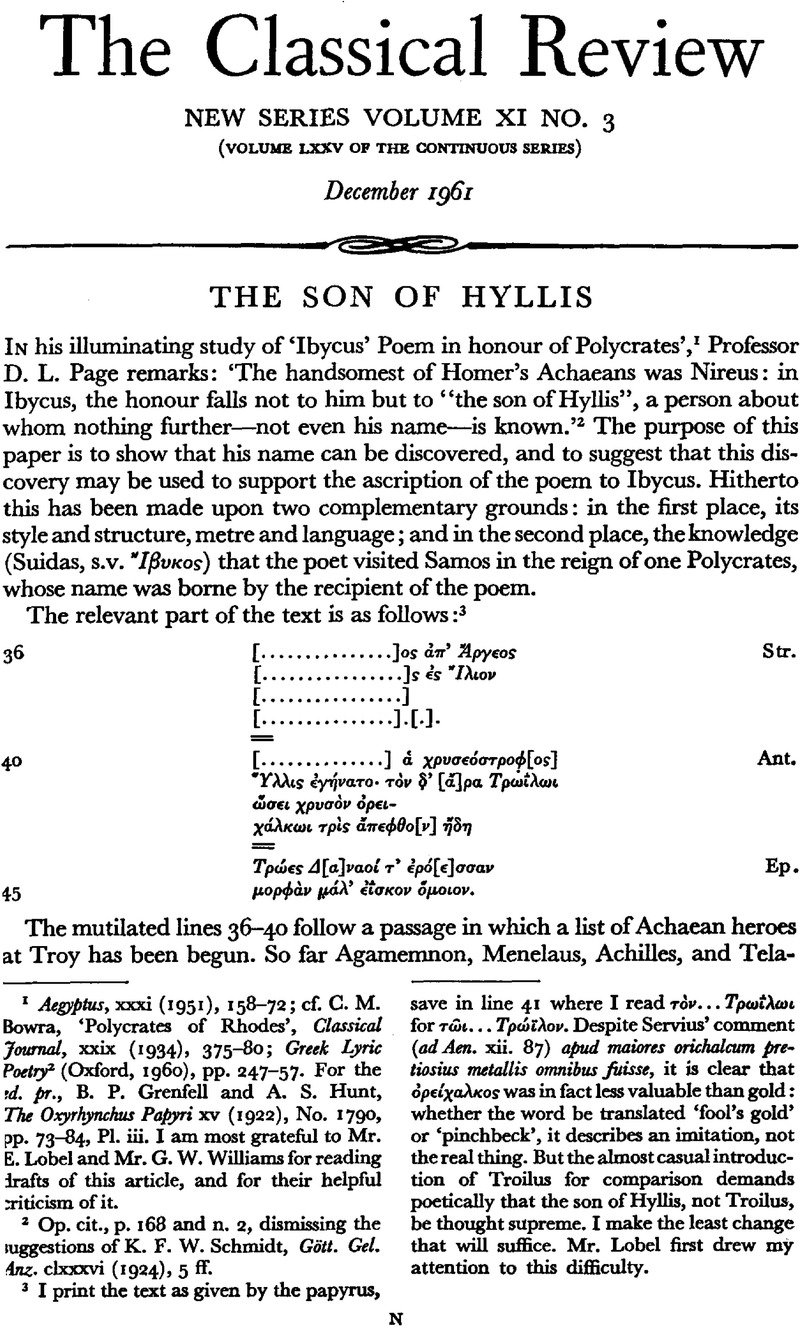Article contents
The Son of Hyllis
Published online by Cambridge University Press: 27 February 2009
Abstract

- Type
- Review Article
- Information
- Copyright
- Copyright © The Classical Association 1961
References
page 185 note 1 Aegyptus, xxxi (1951), 158–172 Google Scholar; cf. Bowra, C. M., ‘Polycrates of Rhodes’, Classical Journal, xxix (1934), 375–380 Google Scholar; Greek Lyric Poetry 2 (Oxford, 1960), pp. 247–257 Google Scholar. For the ed. pr., Grenfell, B. P. and Hunt, A. S., The Oxyrhynchus Papyri xv (1922), No. 1790, PP, 73–84, pl. iiiGoogle Scholar. I am most grateful to Mr. E. Lobel and Mr. G. W. Williams for reading drafts of this article, and for their helpful aiticism of it.
page 185 note 2 Op. cit., p. 168 and n. 2, dismissing the suggestions of Schmidt, K. F. W., Gött. Gel. Anz. clxxxvi (1924), 5 ffGoogle Scholar.
page 185 note 3 I print the text as given by the papyrus, save in line 41 where I read τ⋯ν…Τρωΐλωι for τ⋯ι…ΤρώΪλον. Despite Servius' comment (ad Aen. xii. 87) apud maiores orichalcum pre-tiosius metallis omnibusfuisse, it is clear that ⋯ρε⋯χαλκος was in fact less valuable than gold: whether the wordbe translated ‘fool's gold’ or ‘pinchbeck’, itdescribes an imitation, not the real thing. But the almost casual introducirafts tion of Troilus for comparison demands poetically that the son of Hyllis, not Troilus, be thought supreme. I make the least change that will suffice. Mr. Lobel first drew my attention to this difficulty.
page 186 note 1 The dittography of sigma was noticed and corrected by Müller, K. O. before the discovery of Ox. Pap. xv. 1790 Google Scholar: Die Dorier 2 (Breslau, 1844), p. 82 and n. 1Google Scholar, giving no reason for the change; cf. von Wilamo-witz-Möllendorff, U., Philolog. Untersuch., i: Aus Kydalhen (Berlin, 1880), p. 147 Google Scholar.
page 186 note 2 There may be a reference to Sicyon in the extremely mutilated scholion at the foot of the last column of the papyrus text. In the fourth line Hunt read ]θαι τι αλ[…]τού .αομε[δο]ντος με[……] έστρά [τενσε]ν Schmidt' version (loc. cit.) was [έλα]β' Αίγιάλειαν [τήν] τού Άδρά[οτ]ου γυν(αίκα), etc. I consulted Lobel, and he confirmed αιγιααλ-, preceded by [η or] ϒη, but dismissedthe rest of Schmidt's restoration. Among the areas to which the Aegial- group of names belongs is Sicyon. Aegialeus was the first king of what later became Sicyon, and the city was named Aegialeia or Aegiale after him (Paus. ii. 5. 6). Years later, Aegialeus and Aegialeia were son and daughter of the Argive-Sicyonian king Adrastus (Hdt. / 68. 2; Iliad v. 412; cf. Hoefer, R.E. ‘Aigialeus’ Knaack, ibid. ‘Aigiale’ No. 2). [ Hunt's Λαομε[δο]ντος were certain, th question would be settled: Sicyon is th only place where Laomedon and Aegia] occur together; for Pausanias (ii. 6. 5 speaks of ‘Lamedon’, a kingof Aegiale wh gave his daughter Zeuxippe (note the name in marriage to the hero Sicyon. (For th five other Laomedontes known to mythc v. logy see Gunning, R.E.) Lobel, however considers the latter part of the line better read as το⋯ λα…[.] γεναμε[……] έστρά [τευσε]; and if this is right, then the name Laomedon could not appear unless abbreviated (cf. line 2, κ(ατα]λαβ(εῖν)). Th question must remain open.
page 186 note 3 F.Gr.Hist. 250 F. 2, and Jacoby's comm (ii d, pp. 819 ff.); Eusebius, Chron., ed Schoene, i, cols. 174 f., cf. App. i, col. 7 Menaechmus is F.Gr.Hist. 131.
- 1
- Cited by




